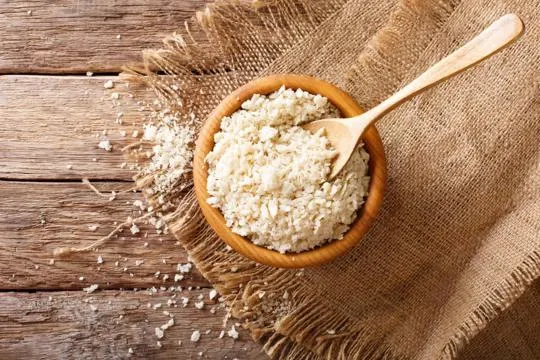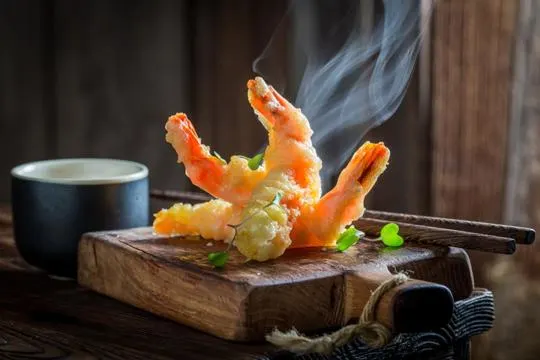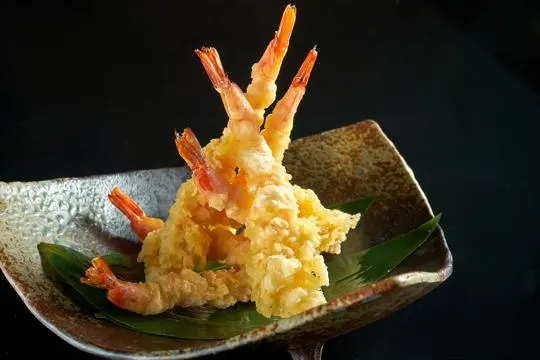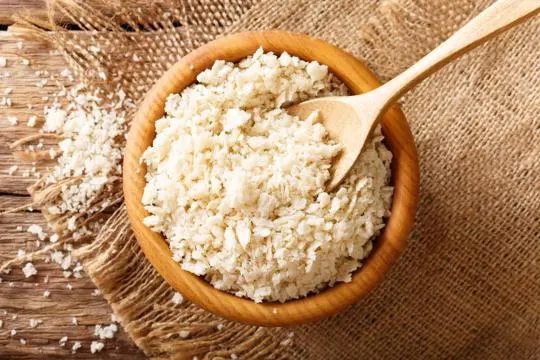Panko and Tempura are staples in our kitchen adventures. Panko hails from Japan, bringing a light, airy crunch to dishes. Tempura? It’s the crispy cousin, offering a delicate, almost ethereal batter.
We’ve all had that moment, standing in the grocery aisle, staring at both, puzzled over which to toss into our cart.
Here’s a fact: Panko is made from bread without crusts, hence its airy texture. Tempura batter mixes flour, water, and sometimes egg, aiming for a lacy golden coat.
Our first experiment with Panko ended in a kitchen that looked like a flour bomb had exploded. Tempura? An epic showdown with hot oil that we barely won.
In short, Panko adds crunch without heaviness. Tempura, a finesse player, wraps ingredients in a light, crispy hug.
Now, we’re no strangers to a breadcrumb dilemma or a batter battle. Our shared experiences? A testament to culinary curiosity and a lack of cleanup enthusiasm.
What is Panko?

Panko, ah yes.
Where to begin? For starters, panko is not just any old breadcrumb; it’s a Japanese breadcrumb that’s prized for its super crispy texture and airy interior.
Unlike regular breadcrumbs, panko is made from bread without crusts, resulting in a lighter and flakier crust when fried or baked.
But don’t be fooled by its delicate appearance—this breadcrumb means business.
Panko is a must-have ingredient for anyone looking to add crunch to their dishes, from coating chicken and fish to topping casseroles and salads.
And the best part? Panko’s unique texture ensures that it stays crispy even when mixed with sauces.
So, in conclusion, if you’re not already using panko in your cooking, you’re missing out on a world of crispy possibilities.
What is Tempura?

Tempura is an amazing Japanese dish. It’s known for its light and crispy coating.
Ingredients such as seafood, fruits, and veggies are dipped in a batter of flour and cold water.
It’s then deep-fried until golden brown.
Tempura started in the 16th century during Japan’s Edo period.
Portuguese missionaries brought it over.
The word “tempura” comes from Latin – “tempora” meaning Ember Days or fasting days.
Over time, it became popular with regional variations.
What makes tempura special is the technique used.
The batter should be mixed gently to avoid activating the gluten in the flour.
This gives a light and crunchy texture.
The oil must also be at an optimal temperature to prevent absorbing too much oil.
Tempura is usually served with tentsuyu – a soy-based dipping sauce.
It can be an appetizer or part of a larger meal.
It shows the simplicity and elegance of Japanese cuisine.
Tempura is a global favorite.
From classic shrimp to veggie rolls, it captures both tradition and innovation within its crispy coating.
Differences Between Panko and Tempura

Panko and Tempura are both Japanese cooking styles. Panko is a light, crispy breadcrumb.
It coats food before frying or baking, giving it a golden crust.
Tempura is a deep-frying method with a flour and water batter.
It dips ingredients like seafood or veggies in the batter, then deep-fries them until they are crisp and golden.
The main difference: Panko is a coating and Tempura is a frying technique.
1 – Texture
Panko and Tempura have unique textures.
Panko is light and airy, while Tempura batter creates a crunchy bite.
These differences are key for flavor.
Panko’s lightness and Tempura’s crispiness enhance any dish.
Understanding texture maximizes the dining experience.
For culinary perfection, choose whether you prefer the lightness of Panko or the crunchiness of Tempura.
2 – Ingredients and Coating
Panko and Tempura are two popular Japanese coatings.
But they are unique in their ingredients and methods.
Panko is made of bigger, crispier breadcrumbs.
These are created by grinding white bread without the crust.
It adds crunch to meats, seafood, and veggies.
Plus, it’s popular worldwide for its lightness and shape-holding power.
Tempura has a lighter batter. Made of flour, egg, water, and sometimes other stuff like baking powder or starch.
When fried, this creates a thin, crispy layer. Unlike panko, which forms flakes.
Panko stands out for absorbing less oil.
This makes dishes with it less greasy, yet with a satisfying crunch.
Plus, you can season it with spices and herbs to enhance the flavor.
In conclusion, both Panko and Tempura provide different textures and flavors.
Try them both to explore new culinary dimensions.
3 – Cooking Method
When it comes to cooking, panko and tempura have different processes.
Panko is coated with breadcrumbs, then baked or fried.
Tempura involves dipping ingredients in a flour, egg and water batter before deep-frying.
This results in different textures and flavors.
Panko, from Japan, is a lighter and crisper texture due to its flakiness.
It’s often used for fried foods such as shrimp or chicken cutlets.
Baking offers a healthier alternative to frying, while still achieving a crunch.
Deep-frying panko-coated food yields a golden brown exterior.
Tempura, also from Japan, has a different technique.
The batter is made from flour, egg and cold water, creating a light and airy mix.
This is used to coat ingredients like vegetables or seafood, then deep-fried in hot oil.
It’s quick cooking time keeps ingredients tender, developing a delicate crispness.
Tempura differs from panko – it highlights natural flavors without overpowering them.
The thin batter creates a light and delicate crust, preserving the freshness of seafood or sweetness of vegetables in each bite.
In conclusion, panko and tempura are similar in that they both involve frying.
However, they differ in terms of breading technique and result.
Panko offers a crispy and flaky coating, while tempura’s light batter allows for showcasing the natural flavors of its ingredients.
Why not try both? It could add variety and deliciousness to your cooking.
Similarities Between Panko and Tempura

Panko and Tempura are two yummy Japanese dishes that have become famous around the world.
Panko is a type of breadcrumb while Tempura is a cooking method.
They both share a Japanese origin, but they differ in their use.
Panko is used as a crunchy coating for deep-fried dishes.
Tempura is lightly battered and fried until golden.
Both Panko and Tempura add flavor and texture to food.
Panko gives a light, airy crunch.
Tempura creates a delicate outer layer and helps keep in natural flavors.
Precise frying is important to get the desired results.
Whether it’s even golden-colored Panko-coated shrimp or fluffy Tempura veggies, accuracy matters.
Panko and Tempura aren’t the same – they serve different purposes.
Panko can be used in many recipes beyond Japanese cuisine.
Tempura is often served at sushi bars and Japanese restaurants.
Culinary Uses and Popular Dishes with Panko and Tempura
Panko and tempura have different uses in the kitchen.
Panko is known for its crunchy texture, which is great for topping dishes like chicken katsu and veggie tempura.
It won’t get too greasy or heavy.
Tempura is a Japanese frying method that coats items in a light batter before frying.
It’s enjoyed as a single item or as part of udon noodle soup or donburi bowls.
Panko is perfect for adding crunch to casseroles, fish fillets, and onion rings.
Tempura has a special process, involving flour and cold water, to get a crisp coating.
So if you want something crispy with your meal, reach for panko or try tempura.
Both offer delicious textures that will leave you satisfied.
Where to Buy Panko and Tempura?
Panko and tempura are two popular elements of Japanese cuisine.
Where can you find them? Look no further.
Grocery stores and online retailers offer these culinary delicacies.
From Asian markets to supermarkets, there’s an abundance of options.
Panko is easy to find in grocery stores.
You can locate it in the baking aisle or where other breadcrumbs are sold.
For more selection or authentic options, Asian markets are the way to go.
These markets carry various brands, including traditional Japanese ones.
There are also flavors and textures to elevate dishes.
Tempura is harder to find than panko. But, have no fear.
Supermarkets with international food sections offer tempura batter mix or pre-packaged tempura shrimp and vegetables.
These sections may also include other Japanese ingredients for making tempura dishes.
Plus, some online retailers cater to Japanese cooking enthusiasts with a variety of tempura products.
Conclusion
In conclusion, there is no one answer to which type of breading is better; Panko or Tempura.
It all comes down to personal preference and the type of meal that is being prepared.
Overall, tempura is lighter and crunchier due to its wet batter, whereas panko is made with dried ingredients and produces a heartier crunch.
If looking for a light coating for fish or vegetables, tempura might be the best option while panko should be used when wanting a thicker crust.
Another consideration when deciding between panko vs tempura breading is the cost as tempura generally costs more than panko due to needing more ingredients and time to prepare.
Ultimately, both types offer an amazing texture and flavor that can complete any meal.
So if you’re ever in doubt as to what type of breading will work best for a certain dish, just think tasting a few pieces coated in either panko or tempura might help make your decision easier.

Leave a comment